Chapter Twelve
The River's Real Residents
Adam Bennett
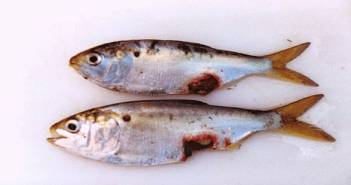
Fig.
1: Wicomico Menhaden with lesions (Photo courtesy of the USGS government
website)
Six young
menhaden were dumped into a metal tub filled with the brackish water taken
from Shiles Creek, a small tributary near the mouth of the Wicomico River.
All six clearly displayed the telltale lesions.
These fish were collected a year to the day, August 6, 1998, after
20,000-30,000 menhaden were killed in the Pocomoke River from
a Pfisteria outbreak. Out
of a total of 238 menhaden collected from Shiles Creek August 4-6, 1998, 50 of
them displayed the bloody lesions characteristic of a Pfisteria
infection.1
Was this the beginning of another massive fish kill on Maryland’s
Eastern Shore? If so this could
be one more thing to add to the growing list of obstacles that Wicomico fish
populations have to deal with. If
something is not done soon to address these problems, future generations may
only know how plentiful the sea life used to be in the Wicomico by reading
about it in a book.
Better Times
Before the time of the European colonists, commercial fishing, motor boats, and pollution problems, the Native Americans that lived along the shore of the Wicomico River would employ crude nets and traps as well as hooks with bait to harvest a variety of fish. They would move up and down the river at certain times of the year to follow the migratory fish such as herring, rockfish, white perch and shad that come upstream to spawn. They could fish year round for residential fish such as bluegill, and largemouth bass. More than likely they would pull in some of the American eels that populated the Wicomico. The river was bursting with life, which probably seemed, at the time, inexhaustible.
They Call It Home
Shad
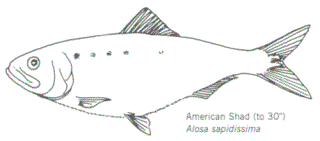
Fig.
2: American Shad (drawing by Alice Jane Lippson)
[2]
The Wicomico is home to basically three types of fish, anadromous, catadromous, and residential. Anadromous fish spend most of their lives out at sea. Only when it is time for them to spawn will they come in from the Atlantic, travel up the Chesapeake Bay and into rivers such as the Wicomico. They come in from the salty ocean to spawn in the freshwaters of the upper Wicomico. A catadromous fish does just the opposite. They spend the majority of their lives living in the river. When the time comes for them to spawn they migrate out to sea. There are also fish that spend their entire lives in the river. These species are known as residential fish. Because of the changing salinity of the river as you move upstream away from the mouth, as well as the differences in oxygen concentrations throughout the river, different types of fish will be found in different parts of the river at different times of year.
One of the major anadromous fish, although the numbers have been dwindling for some time now, is the American shad. From the end of the 1800’s to the mid-1900’s, the American shad was the most valuable fish, both commercially and recreationally in the Chesapeake and its tributaries. [3] Shad travel in schools and are highly migratory. These silvery fish have large, smooth scales and a row of dark spots that run along their sides. They have a thin edged belly and sharp saw like scales called “scutes” that run along it. [4] Throughout the years, shad have probably spawned in every river and tributary that they had access to, from the Bay of Fundy in Canada, to the St. Johns River in Florida. [5] During the spring, they will travel as far upstream as possible to reach the fresh-brackish and freshwater portions of the river. These areas provide a good spawning ground for the shad as well as many other types of anadromous fish like the herring and white perch. [6] These fresher water areas also contain a higher oxygen concentration, which is critical in larval development. A female shad deposits anywhere from 30,000 to 600,000 eggs. [7] The males come along and deposit their semen in this freshwater area and then return to the Chesapeake, and then on to the Atlantic. The fertilized eggs will develop and hatch in about three to ten days as they float downstream. After hatching, the saltwater marshes closer to the mouth of the river provide a nursery for the immature fish where they feed on zooplankton and insects. [8] During the late fall months, most of the young shad will migrate to areas near the shore where they spend the winter. Some of these shad will remain in these areas for up to a year before finally venturing into the Atlantic. Once the shad reach the sea they will remain there for three to five years before returning to the river to spawn. [9]
The commercial fishing of shad increased throughout the 19th century, eventually peaking at around 7.1 million pounds in 1890. [10] The fishing was so successful in fact, that in 1896 the portion of the Chesapeake located in Maryland was the fourth largest producer of shad in the entire country. [11] By the late 1930’s, the commercial catch had dropped to 411,000 pounds. [12] The once proud fish has been in steady decline for most of the last century and although there was in increase in the 1950’s the numbers have dropped drastically since then. The trend in the numbers of fish caught in the Wicomico mirrors that of the trend seen in the Bay. There were 84,000 pounds of shad taken out of the Wicomico in 1934. [13] After that the numbers fluctuate a bit, but are generally on the decline until 1953, when the number bottoms out at sixteen pounds taken that year. There was a bright spot in 1956 when the number of shad caught in the Wicomico jumped up to 35,000 pounds. [14] This would be the only bright spot as the shad population steadily declined until 1980, when the populations of shad became so severely depleted that a statewide moratorium on the capture and sale of the fish was put into effect to prevent its local extinction. [15] This moratorium may have prevented extinction, but it did little to increase the numbers of shad. The shad, once so plentiful they could be dipped out of the river with nets during their spawning runs, had fallen victim to the blocking of their spawning rivers by dams and other obstacles, as well as decreased water quality. Many shad never reach their spawning grounds because of fishermen who wait for them with pound nets and gill nets in the deep waters. Fisherman also use dip nets and hook and line in the shallow waters. Shad have been on the decline because of overfishing and the fact that there are simply not enough quality spawning grounds to maintain the levels of shad that were once here. [16]
The American
Eel
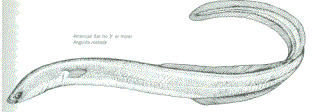
Fig.
3: American Eel (drawing by Alice Jane Lippson)
[17]
The American eel, which is a catadromous fish, lives in the river for the majority of the year unlike the anadromous fish. They can be found in different parts of the Wicomico all twelve months of the year. [18] Although the eel very much resembles a snake, it is a fish. Upon close inspection of one of these sleek, slimy creatures, you will see that it has pectoral fins as well as a very long continuous fin that is the dorsal, anal, and tail fins combined. The slime that coats the eel helps protect it from disease. [19] When it is time for the eels to spawn they travel all the way to the Sargasso Sea, which is in the middle of the Atlantic Ocean, northeast of the West Indies, where they meet eels from all over the world. The migration of the eels begins in the fall and they will not reach the Sargasso until February. The eels travel so far that by the time they get to the Sargasso they have only enough energy to get through the spawning process. Once the spawning is over the eel will simply expire. [20]
The Sargasso Sea is an area of extremely saline and stagnant water about the size of the United States. There is an estimated 10 million pounds of seaweed floating aimlessly around this area. [21] This abundance of plant life provides a fantastic nursery for the young eels. The fertilized eggs left behind will hatch and give rise to long larvae with large teeth. The larvae will drift along with the current back to the Atlantic coast. On their way back to the Wicomico, the larvae develop into a more eel like form known as a glass eel, which are three to four inches long. [22]
The damming of the rivers has not affected the eels as greatly as it has the migratory shad. When a shad comes to a dam in the river its only choice is to stop. This is not so for the determined American eel. They have been known to climb over rocks and wriggle their way up the wet grassy banks of the river in order to avoid obstacles. [23] Of course there are limits to what the eels can do. The construction of a large dam such as the Conowingo found on the Susquehanna resulted in a serious decline of the American eel in that basin. Today there are approximately 11 million fewer eels in the river than in the 1920’s. [24] In the Wicomico, the American eel is still plentiful. Apparently the obstacles along the river are small enough for them to overcome. The number of eels caught by commercial fishermen, have of course, been up and down throughout the years, but there has been no steady decline as there has been with the shad. In fact, the number of eels pulled out of the river seems to be on the rise in the past decade or so. In 1996, the number peaked at 20,800 pounds. The catch has fallen off a bit in the years after that but they are still higher than any time prior to 1996. [25]
Bass
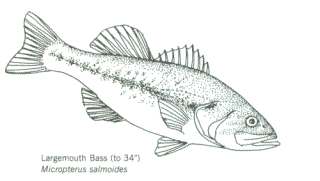
Fig.
4: Largemouth Bass (drawing by Alice Jane Lippson)
[26]
Not all the fish in the Wicomico are migratory. Some never leave the river and are known as residential fish. A good example of this type of fish is the largemouth bass. Bass are known as structure fish, meaning they live in areas with a lot of structure like docks, sunken boats and plant life. By living among these structures the bass are able to avoid the current and stay in basically the same area. They are also able to avoid the current because of the lamellar flow of the river, meaning the Wicomico flows in layers. As you move deeper and closer to the shore the current becomes less and less. The current is the strongest at the top and middle of the river. Bass will generally stay close to the shore to avoid having to fight the current. The food sources of the bass are also found close to the shoreline. Bass populations are most abundant in the upper parts of the river where there is greater structure.
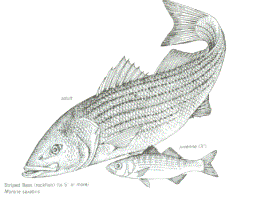
Fig. 5: Striped Bass or Rockfish (drawing by Alice Jane Lippson)
[27]
Another well-known type of bass found in the river is the striped bass, or rockfish. The rockfish, unlike the largemouth bass, is semi-anadromous. The rockfish do not migrate to the freshwater of the upper Wicomico all the way from the ocean. Instead they spend most of their lives in the estuarine waters of the lower Bay and rivers. A mature rockfish will move into the fresh tidal water to spawn during the late winter and early spring. [28] Rockfish have become one of the most popular commercial and recreational fish in the bay. These silver fish get the name striped bass from the dark horizontal stripes found running along the sides of their bodies. [29] At one point in time, rockfish were so plentiful, they were used to fertilize fields. [30] However, in the early 1970’s the rockfish populations were in serious trouble. [31] They have since come back thanks to the laws put in to effect to regulate the catching of rockfish. The Chesapeake Bay and its tributaries are now the primary spawning and nursery grounds for 70-90% of the rockfish stocks on the east coast. [32]
Will They Call It Home Much Longer?
While there is still a large population of many types of fish in the Wicomico, not all of them are thriving like they used to. The water quality has dropped dramatically from the pre-Colombian times, the time before European settlement. This has caused the amount of fish to drop as well. No longer is the Wicomico a pristine clear water fish sanctuary. It now contains damaging nutrients such as nitrogen and phosphorous due to runoff from farms. Along with agricultural runoff there is also runoff from the city of Salisbury and suburban lawns, as well as pollution from the sewage treatment plant and the industries in the area. Phytoplankton and sediment deposits, mostly sand due to erosion, dredging and daily barge traffic, have increased. All of these factors have decreased the oxygen levels and overall quality of the water, especially at the bottom of the river.
Yellow perch were once found in abundance in the river, but this is no longer the case. One of the main reasons for the decline of the yellow perch is the way in which their eggs are deposited in the water. Yellow perch eggs adhere to the bottom of the river in a long string. The bottom of the river has the lowest oxygen concentration and probably the lowest overall water quality of any other part of the river. This does not allow for proper growth and development of the eggs.
Another obstacle that the fish populations, especially the migratory ones, face is the damming of the river. Anadromous fish like the shad can travel up to the dam near Isabella Street at which point they can go no further. This leaves them to spawn in one of the most polluted places in the entire river. This has a very obvious damaging effect on the population. A population is not going to grow and thrive when their lives begin in such a low quality area. The river’s fish populations face many, many obstacles on their way back to where they once were. It is still not known if they will ever return to a time of large numbers and good health.
Water quality and dams are certainly a major concern when discussing the health of the Wicomico fish population. However, there might be an even larger problem that has just recently shown its face. This new obstacle comes in the form of an organism that, unlike the fish, can potentially thrive in the Wicomico despite the river’s current problems.
Pfisteria?
The three inch long, silver menhaden collected that August day in 1998 in Shiles Creek may have displayed the tell tale lesions of Pfisteria but thankfully no other types of fish such as croaker, perch, and white catfish collected in that area at the same time had any type of lesions. [33] In the four years since that collection there has not been another major fish kill on the Eastern Shore. There have been menhaden caught in those years that have had the Pfisteria-like lesions, but all water sample tests have been negative for Pfisteria. [34] Although the tests have proven negative thus far, there is still concern that there could be another outbreak. Since the massive fish kill in the Pocomoke in 1997, the Maryland DNR has been conducting bi-weekly Pfisteria monitoring programs in the waters of the Eastern Shore. [35] This program may be useful in catching another outbreak in time to possibly do something about it.
The
culprit of these fish kills is a microorganism known as a dinoflagellate.
This particular dinoflagellate is known as Pfiesteria
piscicida. It was first discovered in 1988 at the North Carolina School of
Veterinary Medicine. Since that
time it has been said to have caused half of the major fish kills from
Delaware Bay to the Gulf Coast.
[36]
Pfisteria has
a 24-stage life cycle and propels itself during part of its life cycle with
two flagella, which are like little tails.
[37]
Pfisteria can
obtain the nutrients it needs to live in several different ways.
It can photosynthesize what it needs, if it can steal the chloroplasts
(organelles used for photosynthesis) from true algal cells.
[38]
JoAnn Burkholder of
North Carolina State University was the codiscoverer of Pfisteria. She also found that the microorganism can change its eating
habits depending on what food sources are around. When fish are around, Pfisteria will abandon
photosynthesis and become a predator reacting to an undetermined stimulus,
perhaps fish oil or excrement.
[39]
When fish are near, Pfisteria
will secrete a mixture of very powerful toxins.
At least one of these toxins seems to kill the fish, while another
opens up the fish’s skin and causes the lesions.
This open sore allows the organism to feed on the inside of the fish.
[40]
Researchers
have suggested that possible causes of Pfisteria proliferation may be,
“increases in nitrogen and phosphorous from fertilizers and animal feces in
runoff from fields” and “dams that affect the flow and nutrient levels of
rivers, which in turn alters the chemistry of the river’s estuary.”
[41]
An increase in
nutrients like nitrogen and phosphorous in the water will in turn cause an
increase in the algae population, which is a major food source of Pfisteria.
Burkholder reported that in North Carolina, where the organism was
originally discovered, “75 percent of the kills that we’ve observed have
occurred in nutrient-overenriched areas.”
[42]
With all the farm
runoff adding nutrients to the rivers on the Eastern Shore, the presence and
possible outbreaks of Pfisteria are an obvious concern.
The fact that the Wicomico is a dammed river adds to the possibility of
an outbreak. The concern is not
only for the health of the fish population, but also for the health of the
people that come in contact with the river and the social implications that
this situation brings with it
In
September of 1997, a medical team appointed by Governor Parris Glendening,
linked 13 people with memory and health problems to exposure to Pfisteria
infested waters of the Chesapeake.
[43]
Researchers believe
that Pfisteria can cause problems with the central nervous system
resulting in memory loss and problems with certain types of cognitive tests. Brain scans of fisherman who have come in contact with Pfisteria
infested waters and complained of memory loss and struggled with the cognitive
tests, have shown signs of damage. Fortunately,
after three to six months of not working on the water, the fishermen’s brain
functions returned to normal.
[44]
Socially
and politically, blaming the Pfisteria problem on farm runoff can cause
quite a conflict between the watermen and farmers.
It is important to understand some of the details behind this issue in
order to see why there is no easy solution.
The poultry industry is not only big in Salisbury, but all over
Delmarva. There are 600 million
chickens raised on the peninsula annually and the industry continues to grow.
[45]
Today the average
person will eat around 30 more pounds of chicken each year than in 1975.
[46]
Companies like Perdue
Farms Inc., which is located in Salisbury, have kept up with the increasing
chicken consumption by finding ways to raise more and more chickens in less
and less space. This has helped
the state triple its broiler production since 1960.
[47]
Of course with more
chickens comes more manure, and with more manure comes more runoff rich in
nitrogen and phosphorous which enters the river.
These nutrients degrade the water quality and make for an excellent
environment for the Pfisteria. It
seems like the easy thing to do would be to regulate farmers in some way to
reduce the runoff and therefore reduce the threat of Pfisteria.
This is a lot easier said than done.
It is one thing to come down on large corporations and place stricter
regulations on them to reduce pollution.
A large corporation will simply raise its prices in order to keep
turning a profit. Farmers on the
Eastern Shore do not have this luxury. They
have very tight profit margins and they have to keep their prices relatively
low in order to meet the demands of the contracts they have with their
processing companies.
[48]
The poultry industry
provides 25,000 jobs for people living on the Eastern Shore.
[49]
By simply going
through and putting restrictions on the farmers, it could potentially affect
the livelihood of thousands of people.
Conservation
If we really want to do
something about the dwindling numbers of fish in the Wicomico the time for
action is now. There are several
things that have already been done that have made a difference and there are
some others that have yet to be tried. Fish
ladders are a good example of something that has yet to be tried in the
Wicomico. They have proven
effective in other parts of the country and they would most likely make a
difference in this area.
Fish
Ladders
Steve
Hughes of the University of Maryland Eastern Shore is working on developing a
fish ladder at the Isabella Street dam to aid anadromous fish, like the shad,
in traveling further up the river to a more hospitable location.
Passages such as fish ladders have already proven successful in other
parts of the state. In 1999,
$263,755 was approved for the construction of the Wilson’s Mill Fish
Passage. This passage re-opened
25 miles of migratory fish runs that had been closed by mills and dams for the
last 300 years, along Deer Creek, a tributary of the Susquehanna.
[50]
This particular
passage is a Dentil type fish ladder. These
fish ladders are made from concrete chutes constructed on an angle. A series of wooden baffles are then placed in the chutes,
which disperse the energy of the water flowing through it, and allow the fish
to ascend.
[51]
The Lake Bonnie fish
passage is located on Broadway Branch at the headwaters of the Choptank River.
This passage, an Alaskan Steeppass fish ladder, opened 10 miles of
spawning area.
[52]
An Alaskan Steeppass
fish ladder is composed of aluminum and wing-like baffles on both sides that
slow the water to a speed that fish can ascend.
[53]
The goal of the
Maryland Fish Passage, which was established in 1988 and is administered by
the DNR, is to “restore migratory fish populations to as near historic
levels as possible.”
[54]
In the years since
its inception, the program has been used on every major river in the state and
re-opened 292 miles of spawning habitat.
[55]
It is not exactly
clear what characteristics the state uses to define a river as “major”.
Perhaps it is the size or how much use it gets, but certainly our
Wicomico should be considered major enough to receive help from this program.
Rules
and Regs
The
rockfish was in serious trouble before the regulation of the catching of them.
During the 1970’s and early ’80’s, the striped bass commercial
fishery was very popular. It was
so popular that intense fishing pressure drastically reduced the population.
Commercial fishing of striped bass was placed on a five-year
moratorium. In 1989 The Chesapeake
Bay Striped Bass Fishery Management Plan was completed.
The goal of the plan was to strengthen and perpetuate the striped bass
stock in the Bay and its tributaries. It
focused on management of the species to generate long-term ecological,
economic, and social benefits. The
plan called for regulations on size limits, gear restrictions, and
establishment of fishing seasons. It
also called for stock assessment through biological studies and monitoring of
the fish.
[56]
The plan has been
changed and amended a few times since 1989 and overall it has been a huge
success. Rockfish populations
have returned to historic numbers.
Another
good example of conservation is the relatively large population of largemouth
bass despite all the recreational fishing.
There are bass tournaments on the river, but because of the catch and
release practices of the fishermen it has not had a drastic affect on the
population. Even bass brought in for scoring in a tournament are kept in
live wells and most of the time are released back into the river.
For
all the success of the restoration of the striped bass, the same can’t be
said for the American shad, at least not yet. Driven by the declines in the
commercial shad industry, the Atlantic States Marine Fisheries Commission
enacted the 1985 Interstate Fishery Management Plan for American Shad and
River Herring.
[57]
While recommending
general ways for controlling the exploitation, harvest monitoring, hatchery
programs, and habitat restoration, the plan neglected to mention any specific
management measures, like quotas and bag limits.
[58]
This original plan
had little affect on increasing the population so the plan was updated and the
Amendment 1 to the Shad and River Herring Fishery Management Plan was
adopted in October of 1998. This
amendment established much more extensive and specific restrictions.
[59]
In 1989, the Chesapeake
Bay Alosid Fishery Management Plan (FMP) was drawn up. This plan was developed to define the problems associated
with the population decline, possible overfishing, monitoring efforts, and
habitat degradation.
[60]
Starting in 1993, the
Maryland DNR began a project to restock Maryland rivers with American shad,
through hatcheries. Although
there has been a nearly 20 year moratorium placed on the catching of shad, the
populations have not recovered. This
is probably due to the lack of adult spawners.
[61]
Since the hatchery
program began, 5.5 million American shad have been stocked in the Choptank,
Patuxent, Nanticoke, and Patapsco Rivers.
[62]
In 1993, the first
shad juveniles in 30 years, were caught in these rivers, while in 1997, the
first returning American shad adults were caught in the Nanticoke.
[63]
These are good signs
that we are headed in the right direction.
The
restoration of the shad population would not only have important ecological
meaning, but also important social meaning.
There was a time when shad was so important to the people living around
the water. They were important to
the people who made a living from catching them.
They were important to fathers and sons who created bonds while
spending a spring day on the river fishing for them.
They were important to the people who waited for the schools and
schools of shad that made the trip upriver each year to mark the beginning of
spring. The shad were part of
people’s lives and their decline marked the decline of a way of life.
Author Tom Horton muses:
“If the shad does not
return, perhaps it is because we do not love it enough…Who can say at what
point of the shad’s decline it was that the decline in people who had
enjoyed it, whether on a plate or on the hook, became a telling factor.”
[64]
Gone
are the days of racing your friends down to the river for a swim or getting up
early to throw your line into the water and wondering, not if you will catch a
fish, but how many you will catch. Today
we have to worry about nitrogen and phosphorous levels or when the next
outbreak of Pfisteria will occur.
Maybe by restoring the shad to what they once were, we will be able to,
in some small way, begin to restore the spirit of the river to what it once
was.